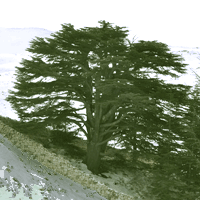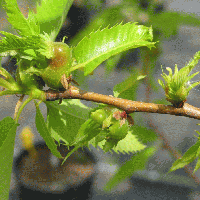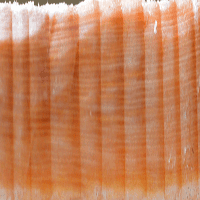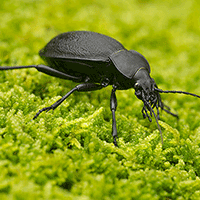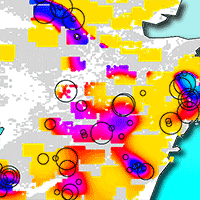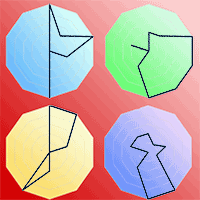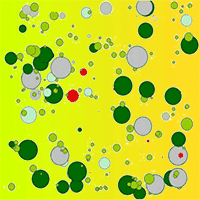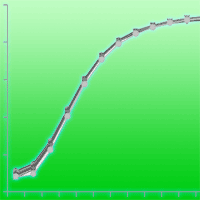
Stand structure and regeneration of Cedrus libani (A. Rich) in Tannourine Cedar Forest Reserve (Lebanon) affected by cedar web-spinning sawfly (Cephalcia tannourinensis, Hymenoptera: Pamphiliidae)
Sarita Bassil (1), Salim Kattar (1) , Rafael M Navarro-Cerrillo (2), Miguel Angel Navarrete Poyatos (3), Nabil Nemer (4-5), Guillermo Palacios Rodríguez (3)
iForest - Biogeosciences and Forestry, Volume 11, Issue 2, Pages 300-307 (2018)
doi: https://doi.org/10.3832/ifor2502-011
Published: Apr 13, 2018 - Copyright © 2018 SISEF
Research Articles
Abstract
The analysis of forest structure is a useful tool to understand stand biodiversity characterizing forest ecosystems, and could help in suggesting appropriate management plans. Cedar forests in Lebanon are remnant patches that survived past human activities but are still threatened by other different anthropogenic and natural disturbances. Among these threats, the cedar web-spinning sawfly (Cephalcia tannourinensis) discovered in Tannourine Cedar Forest Nature Reserve in 1997, which is able to cause the death of trees. The aim of this study is to investigate the impact of this pest on the stand structure and regeneration of Cedrus libani in Tannourine Cedar Forest Nature Reserve located in North Lebanon. The dependence of stand structural attributes (diameter at breast height, total height and basal area) on the presence of infestation by the cedar web-spinning sawfly was identified using the Student’s t-test. The Ripley’s K(d) function was used to analyse the spatial pattern of cedar stands. In addition, the diameter, the vertical structure and the crown projection were characterized using the Weibull function and graphic representations. The results showed that stand structure and regeneration are significantly different between infested and non-infested stands. The cedar of Lebanon remains as the dominant species, with abundant young individuals and a good regeneration status (c = 1.0). The analysis of the spatial pattern showed a positive spatial relationship between mature Lebanese cedar trees as well as between mature and juvenile cedars, with a bigger aggregation in infested plots (6 to 10 meters) than in non-infested quadrates (2 to 7 meters), reflecting the impact of the cedar web-spinning sawfly on the stand structure and regeneration of Cedrus libani stands.
Keywords
Cedrus libani, Stand Dynamic, Pest Damage, Spatial Pattern, Vertical Structure, Cephalcia tannourinensis
Authors’ Info
Authors’ address
Salim Kattar
Lebanese University, Faculty of Agricultural and Veterinary Sciences, Dekwaneh, Beirut (Lebanon)
Department of Forestry, Faculty of Agricultural and Forestry, Dendrodat Lab, University of Córdoba (Spain)
Guillermo Palacios Rodríguez
Center for Applied Research in Agroforestry Development (IDAF), University of Córdoba (Spain)
Department of Agricultural Sciences, Faculty of Agricultural and Food Sciences, Holy Spirit University of Kaslik, Jounieh (Lebanon)
Tannourine Cedar Forest Nature Reserve, Scientific Coordinator, Tannourine El Fawka (Lebanon)
Corresponding author
Paper Info
Citation
Bassil S, Kattar S, Navarro-Cerrillo RM, Navarrete Poyatos MA, Nemer N, Palacios Rodríguez G (2018). Stand structure and regeneration of Cedrus libani (A. Rich) in Tannourine Cedar Forest Reserve (Lebanon) affected by cedar web-spinning sawfly (Cephalcia tannourinensis, Hymenoptera: Pamphiliidae). iForest 11: 300-307. - doi: 10.3832/ifor2502-011
Academic Editor
Susanna Nocentini
Paper history
Received: May 25, 2017
Accepted: Jan 12, 2018
First online: Apr 13, 2018
Publication Date: Apr 30, 2018
Publication Time: 3.03 months
Copyright Information
© SISEF - The Italian Society of Silviculture and Forest Ecology 2018
Open Access
This article is distributed under the terms of the Creative Commons Attribution-Non Commercial 4.0 International (https://creativecommons.org/licenses/by-nc/4.0/), which permits unrestricted use, distribution, and reproduction in any medium, provided you give appropriate credit to the original author(s) and the source, provide a link to the Creative Commons license, and indicate if changes were made.
Web Metrics
Breakdown by View Type
Article Usage
Total Article Views: 53286
(from publication date up to now)
Breakdown by View Type
HTML Page Views: 45549
Abstract Page Views: 3654
PDF Downloads: 3070
Citation/Reference Downloads: 16
XML Downloads: 997
Web Metrics
Days since publication: 2797
Overall contacts: 53286
Avg. contacts per week: 133.36
Citation Metrics
Article Citations
Article citations are based on data periodically collected from the Clarivate Web of Science web site
(last update: Mar 2025)
Total number of cites (since 2018): 6
Average cites per year: 0.75
Publication Metrics
by Dimensions ©
Articles citing this article
List of the papers citing this article based on CrossRef Cited-by.
References
Les principaux arbres du Liban. Le Fascicule des essences forestières du Liban [The main trees of Lebanon. The forest species booklet of Lebanon]. Document prepared by the team of the Project Assistance for the Protection of the Green Cover in Lebanon, Ecologia Mediterranea, pp. 65. [in French]
Gscholar
Spatial analysis, a guide for ecologists. Cambridge University Press, Cambridge, UK, pp. 358.
Gscholar
State of Lebanon’s forests 2007. IUCN-2007-060, Association for Forests Development and Conservation, Beirut, Lebanon, pp. 128.
Gscholar
Structure and spatio-temporal dynamics of cedar forests along a management gradient in the Middle Atlas, Morocco. Forest Ecology and Management 289: 341-353.
CrossRef | Gscholar
Biologie et écologie chimique de deux nouveaux ravageurs en cédraies libanaises : Cephalcia tannourinensis Chevin (Hym.,Pamphiliidae) et Ernobius libanensis n.sp. (Col.,Anobiidae) [Biology and chemical ecology of two new Lebanese cedar pests: Cephalcia tannourinensis Chevin (Hym., Pamphiliidae) and Ernobius libanensis n.sp. (Col., Anobiidae)]. MSc thesis, University Paris XI Orsay, Paris, France, pp. 218. [in French]
Online | Gscholar
108 years of change in spatial pattern following selective harvest of a ponderosa pine stand in northern Arizona, USA. Journal of Vegetation Science 20: 79-90.
Gscholar
Biometry: the principles of statistics in biological research. WH Freeman and Co., New York, USA, pp. 887.
Gscholar
Rings, circles and null-models for point pattern analysis in ecology, Oikos 104: 209-229.
Gscholar

